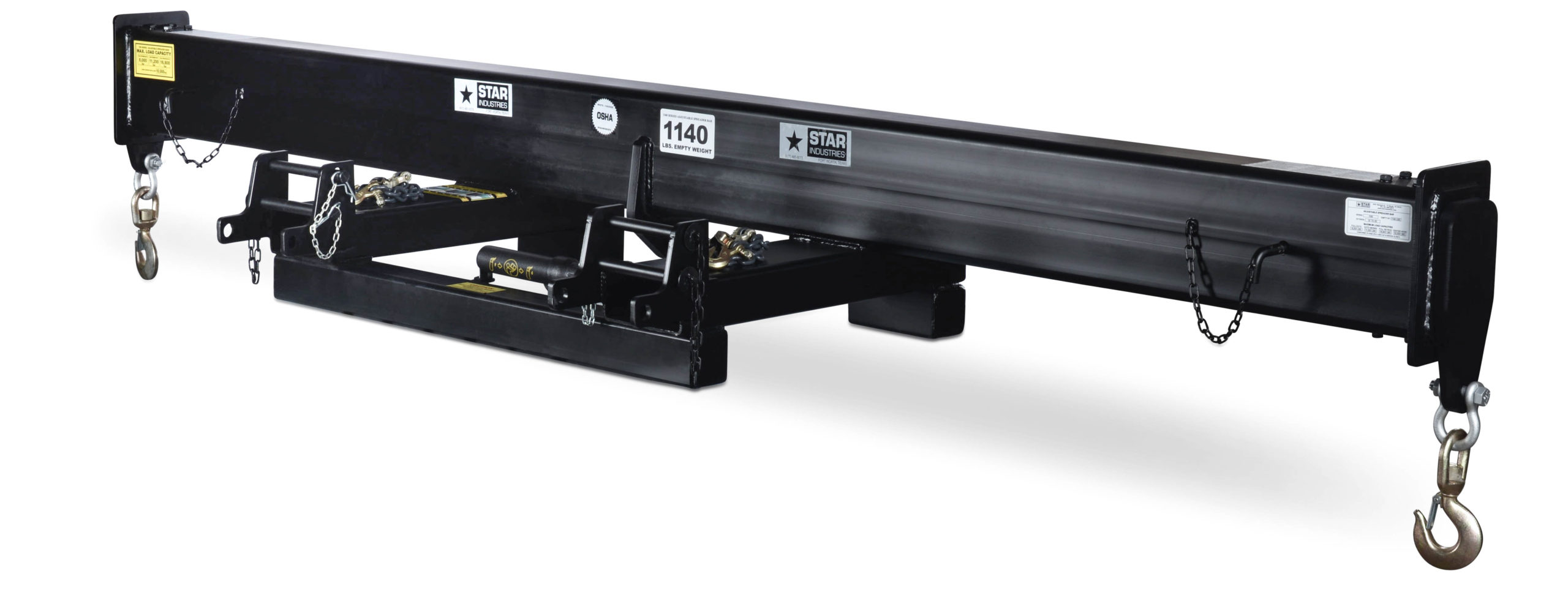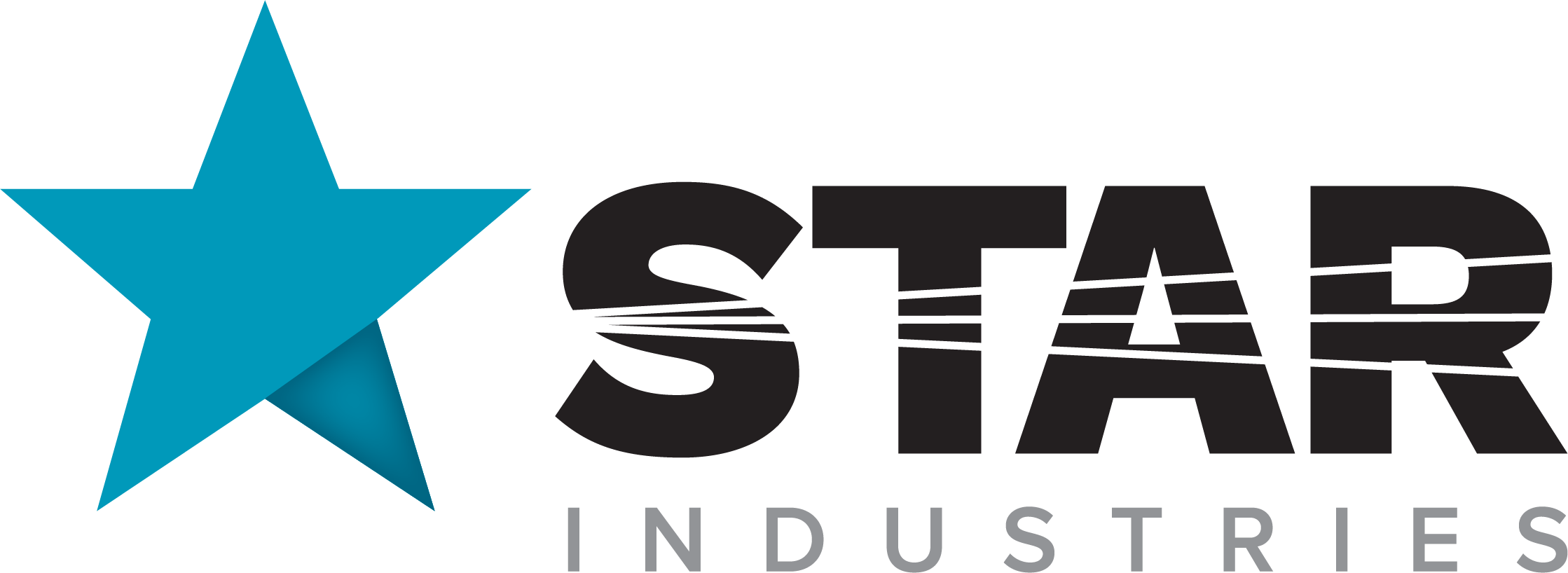Common spreader bar mistakes and how to avoid them to make your workplace safer
Photo A below shows a typical scene acted out at thousands of job sites every day. To a casual observer all looks fine. But it isn’t. This seriously violates jobsite safety and could have resulted in a potentially dangerous lifting accident.
It’s important to have the right tools for maintaining workplace site safety. Take a closer look and you’ll see that the bar is homemade—it isn’t a forklift attachment that is certified to meet ANSI safety standards.
Critically, it lacks the proper locks, anchor points and safety chains to secure the bar to the fork. There is a real risk of this bar sliding forward under load and endangering nearby workers and structures and more so, the risk such an ad hoc approach can pose to productivity and timeliness of project completion.

Photo A
What the legislation says about forklift attachments
ANSI safety standard 6.2.23 and 6.2.24 are quite clear that all forklift attachments must meet strict manufacturer criteria.
6.2.23 of the ANSI standards states:
- Do not modify the rough terrain forklift truck, or the attachment, without prior written consent from the manufacturer.
6.2.24 of the ANSI standards further states:
- Do not use an attachment that has not been approved by the rough terrain forklift truck manufacturer, or if the required load chart is missing.
Clearly the operator of this photo has failed to meet obligations in both.
Makeshift, homemade, modified, or ad-hoc forklift attachments violate the ANSI safety standard set. These standards are established to maintain the productivity and the safety of your jobsite and health and wellbeing of your workers.
Two more examples of dangerous practice
Here are two more examples of poor spreader bar practice.
The set up and rigging in Photo B poses danger at three critical points.
Can you point out the safety issues of the telehandler attachment use in this photo?
The first—as in Photo A—is that the bar is not adequately secured to the telehandler. Spreader bars must be attached to each fork with locking pins and secured by safety chains to a strong part of the forklift carriage making sure the chains are not slack and installed as close to a straight horizontal pull as possible. Not following these safety guidelines when hauling or lifting can lead to workplace hazards, increased costs, and safety violations.
The second failure is that the bar is not perfectly level with the bar’s left and right anchor points. It’s sitting at slightly different angles. This causes unnecessary straining of the bar’s hook mechanisms and compromises the stability of the lift. Again, this is a potentially dangerous situation that could be easily avoidable with the properly manufactured lift attachments.
The third area of concern is that the load is not evenly distributed under the spreader bar and hangs more to the right of the photo than the left. This can cause tipping and depending on the nature of the rigging, lead to load spinning. Following forklift and telehandler attachment guidelines can greatly reduce the risk of jobsite accidents.

Photo B
Photo C is another example of poor (read non-existent) installation of the spreader bar to the telehandler. To compensate for the proper lack of fixing, the operator has tilted his forks on an unnecessary aggressive reverse angle towards the forklift.
This goes against ANSI standards and guidelines which state:
- When stacking or tiering, use only enough backward tilt to stabilize the load.
And
- Although the use of maximum rearward tilt is allowable under certain conditions, such as traveling with the load lowered, the stability of a rough terrain forklift truck as determined by the tests outlined in para. 8.6 does not encompass consideration for excessive tilt at high elevations or the operation of truck with excessive off-center loads.
Equipment safety protocols, jobsite standards, and heavy equipment best practices are developed to protect the security and welfare of your project, your equipment, and your staff. Ignoring these through modifying attachments or by operators ignoring the equipment safety protocols can lead to deadly workplace accidents.

Photo C
Rules to follow for spreader bar safety and usage
We’ve put together this handy list of rules for maintaining a safe worksite and staying within the outlined forklift and attachment safety protocols when using a spreader bar. Please reach out to a Star industries team member If you have any questions about safety protocols or standards, or desire further information about our equipment attachments.
Use only an engineer-certified spreader bar for your telehandlers and forklifts
The legislation is black and white. Under no circumstances can you use an attachment that does not meet the manufacturer’s strict engineering criteria. Using an attachment that isn’t certified violates legislation and endangers the workplace and your workers. A certified forklift attachment will display a clearly labelled decal showing all necessary information such as year of manufacture, maximum weights and rated lift capacity and empty weight capacity of the attachment. An engineer-certified spreader bar will also possess proper locks, retaining pins, anchor points and safety wrap chains.
Disregarding these can lead to accidents. The most dependable way to avoid accidents is to follow legislation and safety protocols by using a certified attachment.
Understand the beam’s purpose and never exceed its capacity
Spreader bars are used to support long loads during lifts. Their purpose is to eliminate the hazard of the load tipping, sliding, or bending as well as the possibility of low sling angles and the tendency of the sling to crush the load.
It’s important to understand the limitation of not just the bar but also the capacity of forklift using it.
Staying within the capacity, ratings and safety protocols of your forklift attachments not only helps avoid costly accidents — it’s is also the best way to get the most out of your workers and equipment.
You can obtain this information by contacting Star Industries. When it comes to attachment safety, our experts are happy to take as long as needed. You can also refer to the information clearly labelled on your forklift, telehandler and equipment attachments.
Always inspect the forklift attachment to make sure it is in good condition
There must not be any broken welds in the attachments you use. There shouldn’t be any deformation of the steel tube or other component. There shouldn’t be any cracks in the steel. Inspect swivel hooks and shackles to make sure they are complete, are in good condition, and shackle anchor screw pins or bolts are tight. Check to make sure the fork retaining pins have hair pins to secure them in place and safety chains are properly secured to anchor blocks and grab hooks are properly secured.
Rig it correctly and distribute the load evenly
Safety mishaps often occur from loading the spreader bar poorly or lifting materials beyond its stated capabilities. Evaluate irregular shaped loads before lifting, and make sure the equipment attachments you are using are suitable for the task. Always distribute loads evenly between both sides of the bar.
This will prevent unnecessarily straining of the bar’s hook mechanism, compromises to the stability of the lift, and damage to the load or accidental injuries or damage to property.
Above all, follow the ANSI rules and guidelines to maximize safety, and minimize hazardous situations, and the chance of property damage or workplace injury. Never attempt to compensate for improper loading by misusing your forklift or attempting to use flawed, inappropriately rated, or makeshift attachments. If you ignore the uses, load and capacity ratings of your equipment and attachments, or circumvent forklift safety protocols or ANSI and OSHA standards, you’re endangering your equipment, contracts, your workers and your worksite.
Finally, keep in mind what ANSI Standards 6.2.23 and 6.2.24 state:
- Do not modify the rough terrain forklift truck, or the attachment, without prior written consent from the manufacturer.
- Do not use an attachment that has not been approved by the rough terrain forklift truck manufacturer, or if the required load chart is missing.
What to look for in a spreader bar for your forklifts and telehandlers
Any spreader bar must be engineered to meet all ANSI and OSHA regulations and suitable for your type of forklift. It needs to be plated to manufacturer specifications, including capacity and operation. If your forklift spreader bar doesn’t have these specifications clearly labelled, it’s recommended you don’t use it on your job site. Recommended safety features include secure pin plates to capture the heels of the forks, safety chains to capture the carriage, and a rugged construction that is free of cracks, broken welds and deformations that can lead to critical failures and workplace safety issues.

- Universal “slip-on-forks” fit for both straight mast and extendable reach forklifts (including rough terrain)
- Fixed length and extendable spreader bars available
- Clearly labelled specifications and ratings
- USA Made and meets or exceeds manufacturer requirements for safety
- Includes proper locks, retaining pins, anchor points and safety wrap chains
